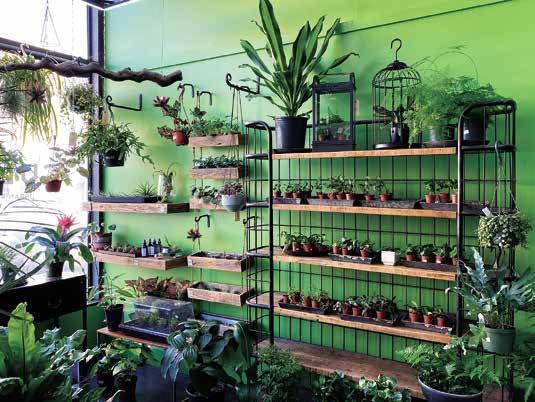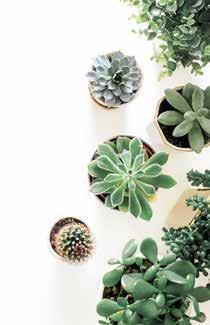
7 minute read
CHANNELING OUR
Channeling Our Inner Botanist
Plants sustain us. Like air and water, we need plants to survive. As it turns out, indoor plants don’t just look good, they also play a role in human health and comfort, according to the Journal of Environmental Science and Pollution Research. The secret is out, too. In the past three years alone, sales of houseplants in the United States rose by almost 50 percent, according to the National Gardening Association (Garden.org). Many experts, including Tony Abruscato, founder of the Chicago-based nonprofit Get Growing Foundation (GetGrowingFoundation.org) and Plant Truck Chicago, a mobile garden boutique with a mission to inspire the next generation of gardeners, attribute the rise mostly to Millennials. by Megy Karydes
Advertisement
Fewer Keystrokes, More Tranquility Houseplants are suddenly in vogue again. “Studies and reports show that millennials are seeking to have ownership and care for something, but not necessarily as much as a pet,” says Abruscato. Social media has helped fuel interest, too. It’s hard not to see beautifully-staged photos of urban jungles inside apartments and not wish our own space could be filled with lus cious leafy plants and succulents.
Because we spend between 80 to 90 percent of our time indoors, it’s no surprise that what’s inside our homes and workplaces are important for our health. The fact that most plants are also a shade of green helps, as the color creates relaxation, represents nature (which is calming for many) as well as emergence or new beginnings, says LaManda Joy, founder of City Grange Garden Center (CityGrange.com), in Chicago. “Fundamentally, we have existence because of the oxygen-making properties of plants, so perhaps deep down, we know our life depends on plants and the color green,” Joy notes.
Color psychology definitely plays a role in why we’re attracted to plants, according to Louise Rosenberg, owner and curator of Cultivate Urban Rainforest & Gallery, in Evanston (CultivateUrbanRainForest.com). Like Joy, she feels green’s calming tone and that houseplants bring us closer to nature help us manage some of the stress we might be feeling with what’s happening in our world. “Folks are dealing with some serious challenges in the world today, most importantly with the environment, along several other aspects of people’s lives. This is especially true for the younger generations,” Rosenberg says. “Besides the color being calming, I have observed many people touching houseplants. While I do not encourage touching plant leaves all of the time, I do recommend checking the soil regularly for a few reasons. One is to check down into the soil to see if it is time to water your plants. Another great reason to get your hands into your soil is that it can make you feel happy.” According to Medical News Today, friendly bacteria in soil can even activate the production of the brain chemical serotonin. “I think caring for houseplants helps people to feel more connected to the natural world,” she advises.
In a world filled with digital pings and endless screen time, caring for houseplants also serve another purpose as a form of therapy. Simply caring for a plant just a few minutes a day or once a week provides enormous benefits and offers us a sense of tranquility and wellness that we can cultivate indoors. “There’s therapeutic value to our mind, body and spirit of having green and growing spaces,” says Lisa Hilgenberg, horticulturist at the Chicago Botanic Garden, in Glencoe (ChicagoBotanic. org). To maximize our happiness and wellness quotient, it’s worth taking the time to find the right houseplant.
Right Plant, Right Place As for those perfectly-designed Instagram posts that feature succulents on an adorable shelf or magazine spreads that seem like a family is living in a jungle, most are staged for that perfect photo, according to Lisa Eldred-Steinkopf, founder of The Houseplant Guru (TheHouseplantGuru.com) and author of books on houseplants, including Houseplants: The Complete Guide to Choosing, Growing, and Caring for Indoor Plants. In order for plants to thrive,
Eldred-Steinkopf says we must choose the right plant and consider the right place in our homes for them to grow. She would like to dispel the myth that it’s hard to grow houseplants. “I love plants, and it’s really all about paying attention to them,” Eldred-Steinkopf says. “Anybody can have a green thumb, you just have to meet your plant’s needs. They need light, they need water, they could use some fertilizer,” she notes. People forget about the fertilizer, but it’s helpful during the growing season.
Don’t Forget Lighting Hilgenberg is concerned that people worry more about how much they water their plants instead of thinking about the lighting. Swapping that kind of thinking might provide more success when it comes to keeping their plants alive, she says. Also, don’t forget that lighting changes throughout the year, so plants may need to be moved around your home for the right lighting. Eldred-Steinkopf recently wrote the book Grow in the Dark: How to Choose & Care for Low-Light Houseplants specifically to help those that don’t have the benefit of spaces bathed in natural sunlight.
Still, watering befuddles many houseplant owners. “Contrary to popular belief, the biggest ‘health’ issue most houseplants face isn’t neglect but too much love, usually in the form of overwatering,” says Joy. “Luckily, if your plant is on the downhill slide, unless something drastic has happened, like it was attacked by a pet, you often have time to correct the issue.”
“A majority of plants can thrive with weekly watering and we have started a campaign for ‘Water Wednesdays’ as a way to remind people to water their plants,” says Abruscato, who states how much watering is necessary is often the most common question he’s asked.
When customers come through the doors of Rosenberg’s shop in Evanston, which is decorated like a beautiful living room complete with artwork on the walls, she often is asked for plants that are easy to care for. Before providing any recommendation, she always asks the direction of where the light is coming. Then she asks about their lifestyle and how often they’re home and whether they have a pet, small children or travel. “All those things are a factor,” she insists. Their answers will help inform her suggestion.
To help people become better stewards, Rosenberg regularly offers a one-hour introduction Plant Parenthood Workshop, in which she guides participants in finding the right plant for their lifestyle in a friendly,
Where to Shop for Houseplants at Local Independent Stores
n City Grange Garden Center, 5500 N. Western Ave, Chicago
n City Grange Garden Center, 1818 W. 99th, Chicago, opening in the Beverly neighborhood this April, CityGrange.com

n Get Growing Foundation’s Plant Truck CHICAGO, 350 W. Hubbard St., Ste. 605, Chicago, GetGrowingFoundation.org
n Cultivate Urban Rainforest & Gallery in Evanston, 704 Main St, Evanston, CultivateUrbanRainforest.com
Getting Started For those that want to flex their green thumb muscles and get started, Abruscato finds that houseplants are most popular when they are considered low-maintenance and require low or indirect light. “New plant owners seem to be partial to Sansevieria (snake plant), pothos and succulents,” he shares. “We also see interest in aloe vera plants—they are functional and low maintenance.”
He feels Sansevieria tend to be the easiest houseplant. “We always say that it thrives on neglect,” he adds. “And a newer favorite, though not large leaf, is the ‘goldfish plant’.” Joy often recommends the following to those starting out on their houseplant journey: chinese evergreen (Aglaonema sp.), heartleaf philodendron (Philodendron scandens), ponytail palm (Beaucarnea recurvata), sago palm (Cycas revoluta), and ZZ plant (Zamioculcas zamiifolia). While there are many reasons we might choose to bring a houseplant into our lives, most of us will admit the health and wellness benefits are strong. They bring us happiness. “I just think people love plants,” says Joy. “And for those who are space challenged and might not be able to garden outside, a houseplant takes care of the need.” It’s also hard for our experts to choose just one particular plant they love. None would admit to a favorite. “It’s hard for me to just say one,” Rosenberg laughs. “There’s too many to love. Most people only see a handful of offerings at the big box retailers, but there are so many more species available in the trade within a given genus. It’s worth the visit to your local plant shops to see the different species.”
Megy Karydes recently adopted two more houseplants into her ever-growing collection. When she’s not busy watering her babies, as she calls them, you can find her online at MegyKarydes.com.










